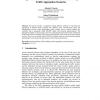Free Online Productivity Tools
i2Speak
i2Symbol
i2OCR
iTex2Img
iWeb2Print
iWeb2Shot
i2Type
iPdf2Split
iPdf2Merge
i2Bopomofo
i2Arabic
i2Style
i2Image
i2PDF
iLatex2Rtf
Sci2ools
JUCS
2008
2008
Approximation to a Behavioral Model for Estimating Traffic Aggregation Scenarios
: This article provides a comparison among different methods for estimating the aggregation of Internet traffic resulting from different users, network-access types and corresponding services. Some approximate models usually used as isolated methods are combined with a temporally scaled ON-OFF model with binomial approximations. The aggregation problem is solved using a new form of parameterization based on the composition of the source traffic accordingly to the concrete characteristics of the users, the accesses and the services. This is a new concept, called CASUAL, included within an overall network planning methodology for the design and dimensioning of Next Generation Internet.
Related Content
| Added | 13 Dec 2010 |
| Updated | 13 Dec 2010 |
| Type | Journal |
| Year | 2008 |
| Where | JUCS |
| Authors | Alberto E. Garcia, Klaus D. Hackbarth |
Comments (0)

